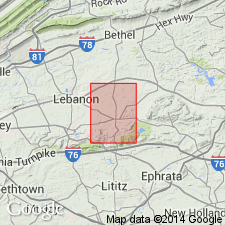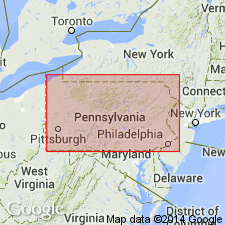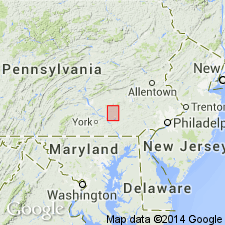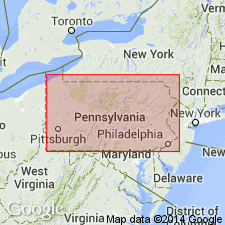
- Usage in publication:
-
- Richland member
- Modifications:
-
- Named
- Dominant lithology:
-
- Dolomite
- AAPG geologic province:
-
- Appalachian basin
Summary:
Named Richland member of Conococheague formation. Unit is dolomite sequence that stratigraphically overlies Millbach member; top is drawn at base of first thick bed of medium-light-gray limestone containing crinoid fragments and other fossils; contact with Ordovician Stonehenge formation is concealed. Basal part of member consists of thick-bedded, medium-light to medium-dark-gray, finely crystalline dolomite that is in part laminated and contains beds of edgewise conglomerate and calcarenite; CRYPTOZOON present at two horizons in lower 120 feet. Chert, which is frequently oolitic, and oolitic medium-gray limestone interbeds occur in the more limy center of member. Upper part of member reflects cyclic sedimentation, medium-gray siliceous dolomites are repeated at least 12 times; these beds are usually overlain by limy dolomite, magnesian limestone, or banded limestone and dolomite; the bands are often broken into conglomerate; above this are typically medium-gray to light-gray dolomites with shaly partings or bands; the cycle then begins again with siliceous dolomite. Total thickness of member probably in excess of 1,300 feet; approximately 1,264 feet at type locality with base not exposed. Age is Late Cambrian.
Named for Richland, Lebanon Co., southeastern PA.
Source: Modified from GNU records (USGS DDS-6; Reston GNULEX).

- Usage in publication:
-
- Richland formation
- Modifications:
-
- Revised
- AAPG geologic province:
-
- Appalachian basin
Summary:
Raised the Richland to the Richland formation of the Conococheague group.
Source: GNU records (USGS DDS-6; Reston GNULEX).

- Usage in publication:
-
- Richland Formation*
- Modifications:
-
- Overview
- AAPG geologic province:
-
- Appalachian basin
Summary:
The Richland Formation of the Conococheague Group consists of medium-gray to medium-dark-gray, finely crystalline, interbedded limestone and dolomite. Limestone commonly contains disseminated grains, patches, or laminae of dolomite and some beds of fine conglomerate and calcarenite. Overlies Millbach Formation of Conococheague Group and underlies Conestoga Limestone. Unit only exposed in small area at east end of Lititz belt. The Richland is of Late Cambrian age.
Source: GNU records (USGS DDS-6; Reston GNULEX).

- Usage in publication:
-
- Richland Formation
- Modifications:
-
- Overview
- AAPG geologic province:
-
- Appalachian basin
Summary:
The Richland Formation in the Lebanon Valley sequence of the Great Valley consists of gray dolomite, in part oolitic, interbedded with medium-gray limestone and dark-gray oolitic chert. Overlies Millbach Formation.
Source: GNU records (USGS DDS-6; Reston GNULEX).
For more information, please contact Nancy Stamm, Geologic Names Committee Secretary.
Asterisk (*) indicates published by U.S. Geological Survey authors.
"No current usage" (†) implies that a name has been abandoned or has fallen into disuse. Former usage and, if known, replacement name given in parentheses ( ).
Slash (/) indicates name conflicts with nomenclatural guidelines (CSN, 1933; ACSN, 1961, 1970; NACSN, 1983, 2005, 2021). May be explained within brackets ([ ]).

